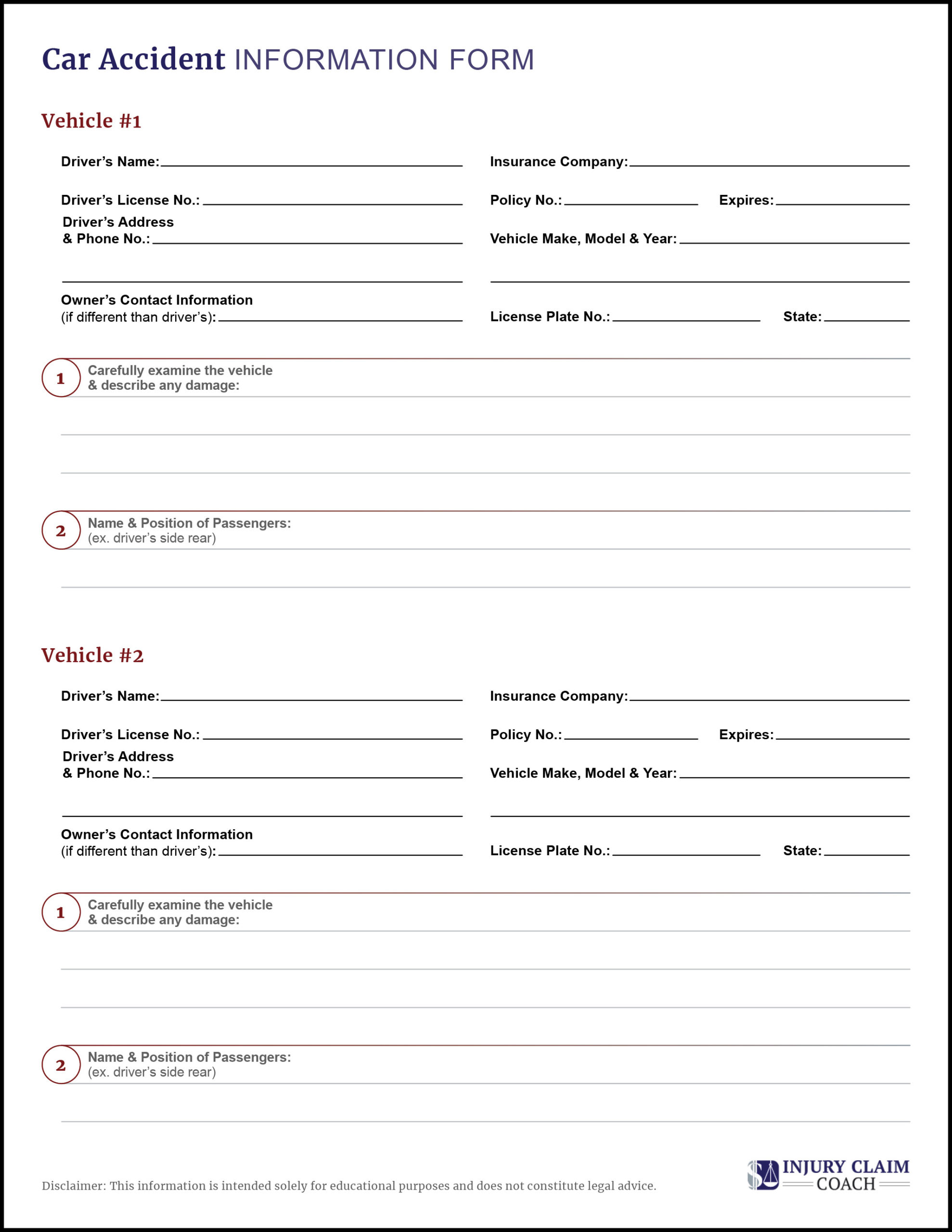
A car accident, even a minor one, can be confusing and stressful. Common sense things you would normally think to do or say can be easily forgotten. This free Accident Information Form was designed to help you capture important details of the accident and build a strong injury claim.
Information gathered at the scene of a vehicle accident can be vital to proving the other driver’s fault, and getting fair compensation from the insurance company.
Click on the image below to download the Car Accident Information Form:



Your first priority after a car accident is safety. Call 911 to report the crash, and ask for help if you or anyone else might be injured. You should also tell the dispatcher if there are any hazards at the scene, like spilled gasoline, downed power lines, or heavy traffic.
Allow emergency medical workers to look you over. This isn’t the time to tough it out. Your body may be pumping adrenaline from the shock of the sudden crash, masking serious injury symptoms.
If paramedics want to transport you to the hospital, let them take you. If you aren’t taken to the hospital from the accident scene, be sure to have a medical evaluation as soon as possible – preferably the same day. You can see your regular care provider or go to the local urgent care center or hospital emergency room.
Refusing or delaying medical attention after a car accident is a terrible mistake. The auto insurance company will jump at the excuse to deny your injury claim by arguing your injuries were not caused by the crash.
Protect yourself by watching what you say after a car accident. Never apologize or admit fault. There may be factors involved that you don’t know about yet. Only discuss the accident with the investigating police officer, and never offer to pay the other driver’s damages.
If you are able to move around the scene, the information you collect can help you make a stronger car accident claim, and maximize your potential compensation. However, do not risk your safety, or aggravate your injuries trying to gather car accident evidence.
Use your cell phone camera to take photographs and video of the scene from as many angles as possible. Get long shots that show the relation of the vehicles to each other. Get close-up pictures of each car’s damage. Take pictures of skid marks, damaged trees or fences, and road conditions. You can’t have too many car accident photographs.
Use the Car Accident Information Form to begin collecting vital information. Start by noting the date, time, and location of the crash. Write down the direction you were going and your approximate speed.
Jot down the environmental factors such as blinding sunlight, wet roads, freezing rain, ice or snow, fog, potholes, and anything else you notice about the conditions.
If you know of anyone else who was hurt in the accident, write down what you know about them, even if you don’t have their names. For example, “Front seat passenger in red sedan bleeding from face cuts.”
Are there pedestrians or drivers who weren’t involved in the crash that saw what happened? Ask witnesses for their names and contact information.
Most states require drivers involved in an accident to share their names, driver’s license number, and car insurance information.
It helps to write down the make and model of the other vehicles involved in the crash, the license plate number, and a description of any visible damage. If there is no visible damage, make a note of that, too.
The Car Accident Information Form makes it easy to write down the key information about other drivers, their vehicles, and their passengers.
You can make side notes if you notice anything that might have a bearing on the accident, like the smell of alcohol, someone trading seats with the driver, or anything being thrown from the car.
While other drivers must disclose their name and contact information, the passengers don’t have to tell you a thing. But they can’t stop you from making notes about their approximate age, appearance, behavior, and where you saw them sitting in the other vehicle.
The sooner you write down a detailed account of what happened before, during, and after the vehicle accident, the better. You will naturally remember more details when the events are fresh in your mind.
There are no unimportant details relating to a motor vehicle accident. Include everything you saw and heard prior to the crash. Did you see the other driver using a phone? Did you hear screeching tires before you were rear-ended? Was the light green when you proceeded through the intersection?
Describe the accident in detail, including what was going on inside your car. Was your head whipped around? Did the airbag deploy or windows shatter? Was your car forced into a spin before it stopped?
Describe what you saw, heard, and felt immediately after the crash. If the other driver apologized or said things like, “I didn’t see the stop sign” make sure you write that down. Pay attention to remarks made by passengers in the other car, such as “I told you to slow down!”
When it’s time to file an injury claim with the at-fault driver’s auto insurance company, the burden will be on you to prove the other driver is liable for your damages. Every scrap of information you gather from the scene of the crash will help you build a solid claim and help you get the compensation you deserve.
Find out now with a FREE case review from an attorney…